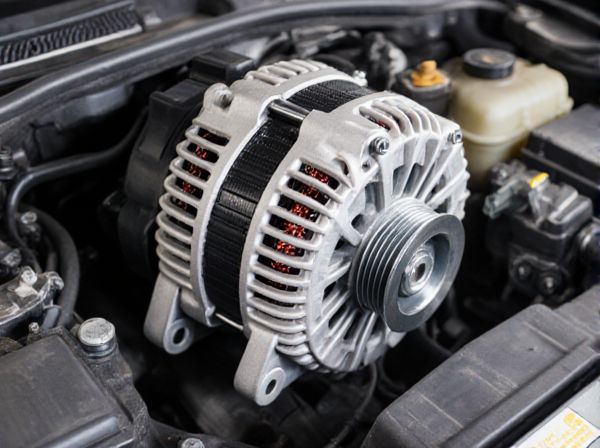
Photo illustration: Self-Excited vs Separately-Excited Alternator
A self-excited alternator generates its excitation current from its own output, using residual magnetism to build voltage, while a separately-excited alternator relies on an external DC source for excitation, allowing better voltage regulation. Your choice depends on the application's need for voltage stability and complexity; self-excited types are simpler and cost-effective, but separately-excited alternators offer precise control and faster response to load changes. Understanding these differences helps optimize performance in power generation systems.
Table of Comparison
| Feature | Self-Excited Alternator | Separately-Excited Alternator |
|---|---|---|
| Excitation Source | Uses its own output to energize the field coil | Uses an external DC power source for field excitation |
| Voltage Regulation | Less stable; depends on load and speed variations | More stable and precise voltage control |
| Complexity | Simple design, fewer components | More complex due to separate excitation circuit |
| Applications | Common in automotive and small generators | Used in laboratory and high-precision applications |
| Cost | Lower cost and maintenance | Higher cost due to additional power source |
Introduction to Self-Excited and Separately-Excited Alternators
Self-excited alternators generate their own magnetic field by using residual magnetism in the rotor and feedback from the output to the field windings, enabling operation without an external power source. Separately-excited alternators rely on an independent external DC power supply to energize the field coils, providing precise control over the magnetic field strength. These differences impact voltage regulation, load response, and overall alternator performance in various electrical power generation applications.
Working Principle of Self-Excited Alternators
Self-excited alternators operate on the principle where the field winding is energized by the output voltage generated by the alternator itself, using residual magnetism to initiate voltage buildup. As the rotor spins, the induced voltage in the stator windings supplies current to the field winding, reinforcing the magnetic field and increasing output voltage in a self-sustaining loop. This contrasts with separately-excited alternators, which rely on an external DC supply for field excitation, resulting in more stable but dependent voltage regulation.
Working Principle of Separately-Excited Alternators
Separately-excited alternators operate by supplying the field winding with an independent external DC source, allowing precise control of the magnetic field strength. The rotor, energized by this separate excitation, creates a rotating magnetic field that induces an alternating voltage in the stator windings through electromagnetic induction. This independent control of excitation current enhances voltage regulation and stability under varying load conditions compared to self-excited alternators.
Key Structural Differences
Self-excited alternators use residual magnetism in their rotor to build the initial magnetic field, relying on the alternator's own output to supply excitation current via a connected field winding, resulting in a simpler and more compact design. Separately-excited alternators require an external DC power source to energize the field winding, offering greater control over the excitation current and improved voltage regulation. The main structural difference lies in the source and arrangement of the field excitation system, with self-excited types integrating the excitation within the alternator and separately-excited types utilizing an independent excitation circuit.
Voltage Regulation Comparison
Self-excited alternators rely on residual magnetism for initial excitation, causing voltage regulation to be less stable and more susceptible to load variations. Separately-excited alternators use an independent DC source for excitation, resulting in precise voltage control and superior voltage regulation under varying load conditions. Consequently, separately-excited alternators provide more consistent voltage output, making them ideal for applications requiring stable voltage levels.
Power Source Requirements and Flexibility
Self-excited alternators generate their own excitation power from the output, eliminating the need for an external power source and enhancing operational sustainability in isolated systems. Separately-excited alternators require an independent DC power supply for the field winding, providing precise control over voltage regulation but increasing complexity and reliance on external sources. The inherent flexibility of separately-excited alternators suits applications demanding stable voltage under variable loads, while self-excited types are more efficient for standalone or less critical systems.
Applications of Self-Excited Alternators
Self-excited alternators are widely used in small-scale power generation, such as portable generators and backup power systems, due to their ability to generate voltage without an external DC source. These alternators are also preferred in remote or off-grid locations where simplicity and independence from an external excitation supply are critical. Their applications extend to renewable energy systems like wind turbines and micro-hydro plants, where the alternator's self-excitation capability ensures consistent voltage regulation under varying load conditions.
Applications of Separately-Excited Alternators
Separately-excited alternators are primarily used in applications requiring precise voltage control and stable operation, such as in laboratory testing equipment, battery charging systems, and electroplating processes. Industrial machinery and power generation plants often employ these alternators because their external excitation allows for independent regulation of output voltage regardless of load variations. This capability makes separately-excited alternators ideal for scenarios demanding consistent electrical performance and high reliability.
Advantages and Limitations of Each Type
Self-excited alternators offer the advantage of simplicity and cost-effectiveness by generating their own excitation voltage from residual magnetism, making them suitable for standalone and portable applications; however, they may experience unstable voltage output under varying load conditions, limiting performance reliability. Separately-excited alternators provide stable and controllable voltage outputs through an independent external DC source for the field winding, improving precision in industrial and power generation scenarios, but they require additional equipment and maintenance, increasing overall system complexity and cost. The choice between self-excited and separately-excited alternators depends on the application's need for voltage stability, cost constraints, and operational complexity management.
Choosing the Right Alternator for Your Needs
Selecting the right alternator depends on your power requirements and application type. Self-excited alternators are ideal for portable generators and applications with fluctuating loads due to their ability to generate voltage without an external DC supply. Conversely, separately-excited alternators offer precise voltage control and stable output, making them suitable for industrial settings and critical systems demanding consistent power quality.
 caratoz.com
caratoz.com